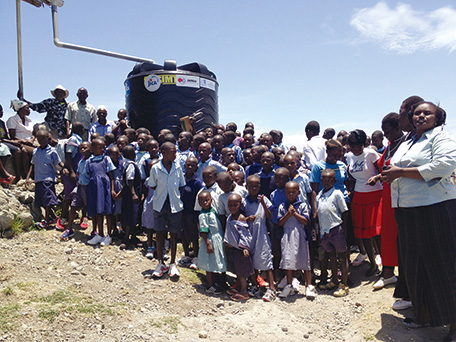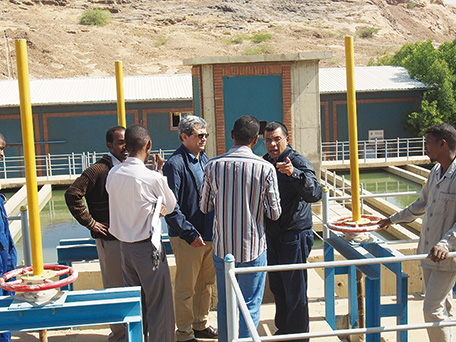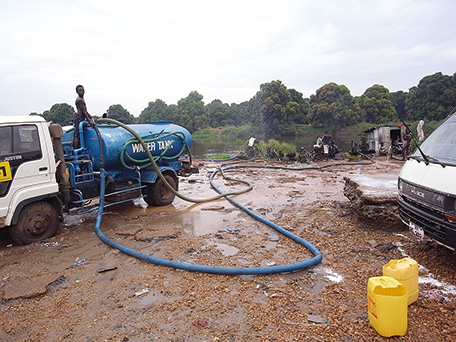(2) Safe Water and Sanitation
Water and sanitation are vital issues linked to human life. In 2015, approximately 663 million people worldwide had no access to safe drinking water, such as piped water and wells, and approximately 2.4 billion people—about a half of the population of developing countries—had no access to basic sanitation facilities, such as toilets and sewage systems.(Note 11) Diarrhea due to lack of safe water and basic sanitation facilities accounts for 11% of the causes of under-five deaths.(Note 12)
In the 2030 Agenda for Sustainable Development, “Ensure availability and sustainable management of water and sanitation for all” is set under Goal 6.
< Japan’s Efforts >
Japan’s disbursements for the fields of water and sanitation are the largest in the world. Japan provides comprehensive support that offers both knowledge and expertise as well as equipment and facilities by drawing on Japan’s extensive experience, knowledge, and technology in these fields, including: (i) promotion of integrated water resources management; (ii) provision of safe drinking water and basic sanitation (improvement of sanitation facilities); (iii) support to enable water use for increasing food production and other purposes (e.g., water for agricultural use); (iv) water pollution prevention (establishing effluent regulations) and ecosystem conservation (conservation of vegetation and sustainable forest management, etc.); and (v) mitigation of damage from water-related disasters (establishment of an early warning system and strengthening the disaster response capacities of communities).
In addition, Japan has supported global efforts, including Sustainable Sanitation: Five-Year Drive to 2015, as the target date for the MDGs. More specifically, at TICAD V held in June 2013, Japan announced that it would continue its assistance for securing access to safe drinking water and basic sanitation facilities for approximately 10 million people and provide assistance for training 1,750 urban waterworks engineers over the coming five years.
Problems such as serious water pollution and the destruction of water-based ecosystems are found in many Asian countries, and lack of information and knowledge regarding these issues is a factor undermining sustainable development in Asia. Against this backdrop, the Ministry of the Environment launched the Water Environment Partnership in Asia (WEPA). Through the cooperation of 13 Asian member countries,(Note 13) this initiative aims to strengthen governance in water environment in Asia by establishing human networks, collecting and sharing information, enhancing the capacity of stakeholders, and other activities.

Pupils and teachers rejoice at the completion of a rainwater reservoir in the Mbita District on the shore of Lake Victoria in Kenya. (Photo: Haruki Kazama)

Moroccan experts visit a water treatment plant in Sudan. Morocco was selected because of its similarities with Sudan—also an Arabic country located in Northern Africa—and various programs were implemented, including trainings and invitation of experts. (Photo: Jun Onodera / JICA)
- Note 11: Source: WHO/UNICEF, “Progress on Sanitation and Drinking Water: 2015 Update and MDG Assessment”
- Note 12: UNICEF, “Committing to Child Survival: A Promise Renewed” (Progress Report 2014)
- Note 13: Japan, Cambodia, China, Indonesia, Laos, Malaysia, Myanmar, Nepal, the Philippines, the Republic of Korea, Sri Lanka, Thailand, and Viet Nam.
South Sudan
Project for the Improvement of Water Supply System of Juba
Grant Aid (August 2012 – Ongoing)

A water tank truck takes water at the bank of the Nile. (Photo: JICA)
South Sudan’s capital city of Juba faces the urgent task of improving its urban infrastructure, which was abandoned and left to deteriorate during the civil war, so as to address the sharp increase in its population resulting from the return of internally displaced persons. In particular, the city’s water supply system, which was constructed in the 1930s, received little maintenance during the civil war for South Sudan’s independence.
In addition, the city’s water treatment capacity has not kept pace with the increasing population. Water supply pipes are old and frequently spring leaks. Most residents depend on water wagons, but these wagons transport and sell water directly from shallow wells or rivers. As such, this water is of poor quality and carries waterborne illnesses.
At the Donors’ Conference on Sudan held in 2005, the Government of Japan announced a plan to provide assistance in the areas of water and sanitation, which are essential to human security. Since then, Japan has conducted fieldwork on South Sudan’s water supply system and since 2012 it has been working on expanding water treatment facilities, and building new water supply facilities and a distribution network in Juba.
Specifically, these activities include the construction of a new water treatment facility equipped with a receiving well, rapid filtration pond, sedimentation pond, clean water pond and sterilizing equipment. Japan has also laid 4.8 kilometers of water supply pipes, as well as 20.3 kilometers of main lines and 32.5 kilometers of secondary lines. Furthermore, to supply more sanitary water, 120 public water taps and 8 water wagon-based supply hubs have been established throughout Juba.
These improvements to the water supply system will result in safer and more secure water supplies, which will help reduce the morbidity rate of waterborne illnesses and alleviate the heavy workload borne by children and women from having to collect water.
At the Fifth Tokyo International Conference on African Development (TICAD V) in 2013, Japan announced its commitment to provide access to safe water and improved sanitation for 10 million people in Africa. The Project for the Improvement of Water Supply System of Juba is part of these efforts. (As of August 2015)
